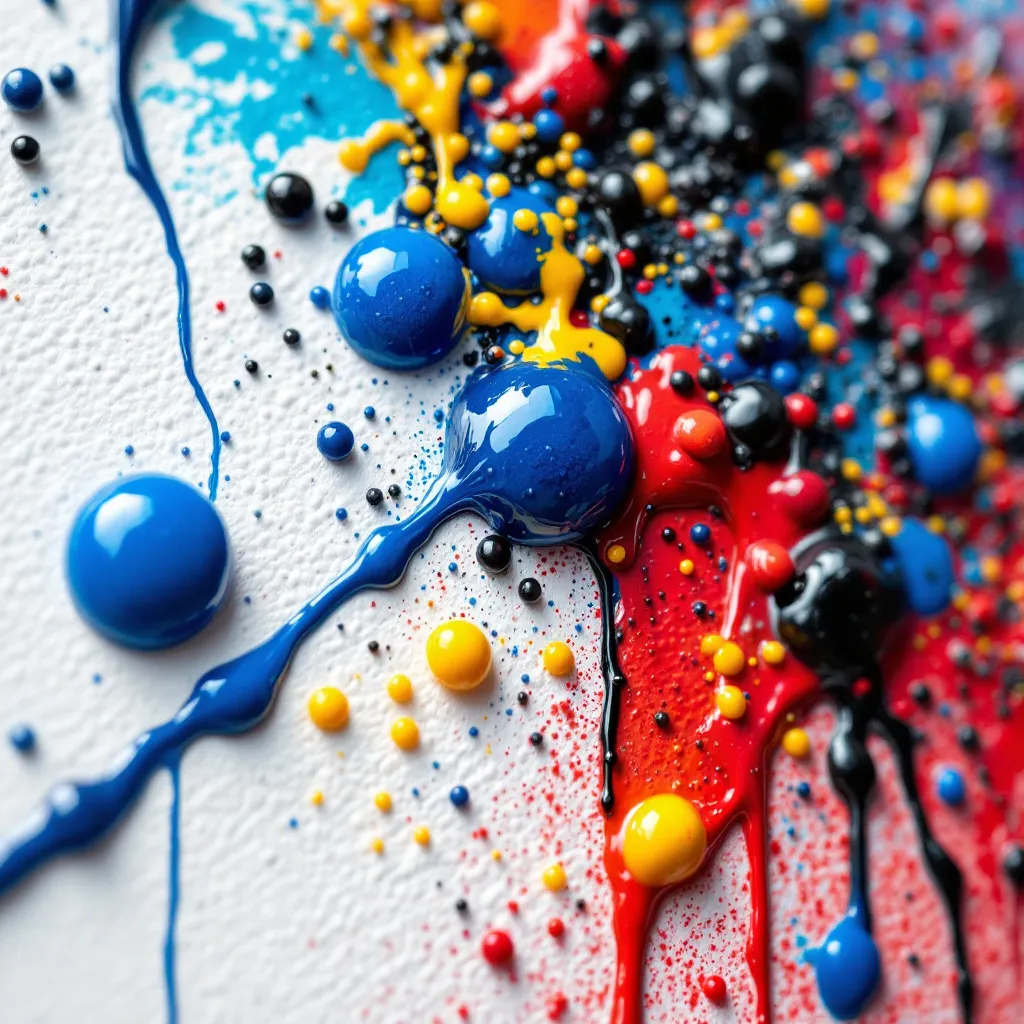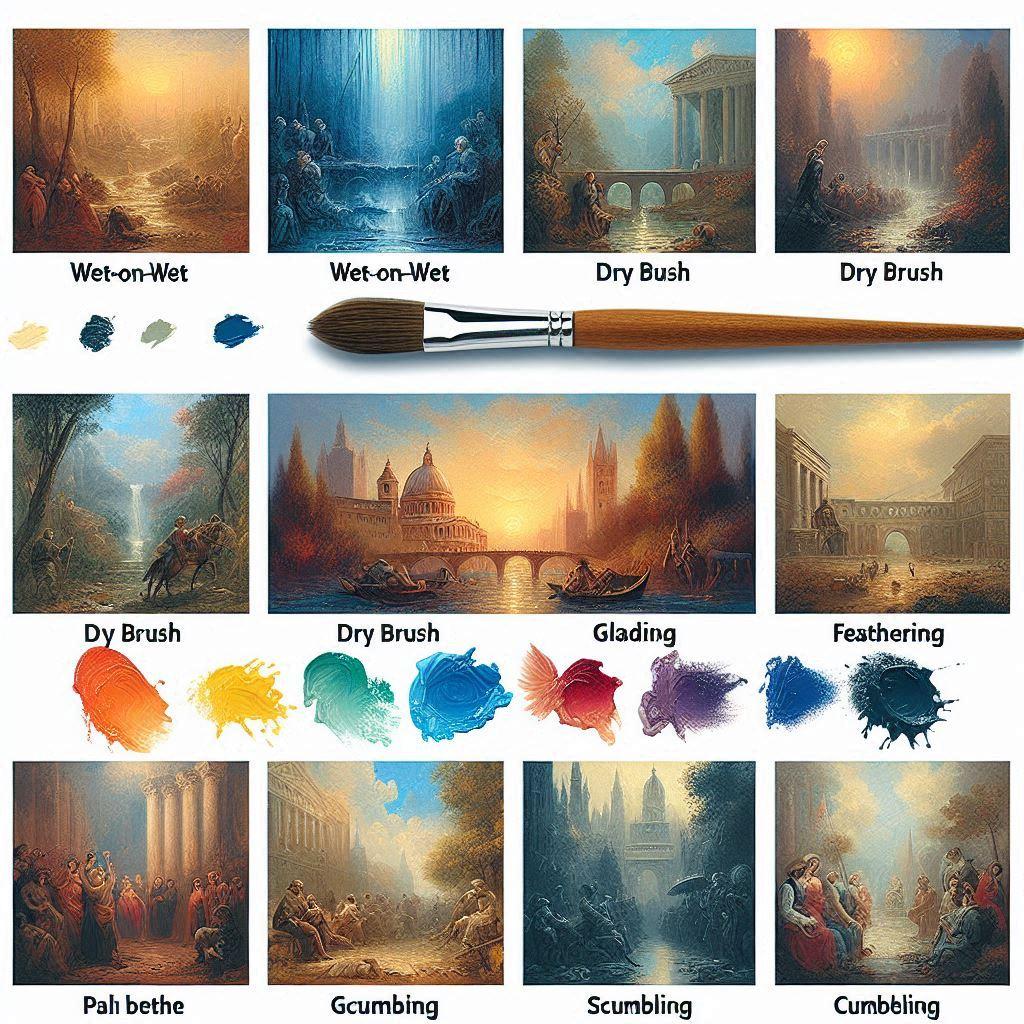Have you ever looked at a painting bursting with colors and shapes that didn’t quite look like anything from the real world, yet it made you feel something? That’s the magic of abstract art! It’s all about expressing ideas and emotions using color, form, and texture, without trying to paint a perfect picture of a person or a landscape. This journey into abstract painting techniques will show you how artists (and you!) can create amazing non-representational art. Forget rigid rules; we’re diving into a world of creative freedom where your imagination is the star. We’ll explore a variety of fun and accessible abstract painting techniques that can help you unleash your inner artist and start making your own unique masterpieces.
Key Point Summary:
- Understanding Abstract Art: Abstract art focuses on colors, shapes, lines, and textures to express feelings or ideas rather than depicting realistic objects.
- Freedom of Expression: The core of these abstract painting techniques is about breaking free from traditional rules and embracing personal creativity.
- Variety of Methods: We’ll cover diverse abstract painting techniques like dripping, pouring, palette knife work, color layering, geometric blocking, and expressive mark-making.
- Accessible to All: Many abstract painting techniques are beginner-friendly and don’t require years of training, just a willingness to experiment.
- Famous Inspirations: Learn how famous artists like Jackson Pollock and Mark Rothko used these techniques to create iconic works.
- Beyond the Canvas: These skills can enhance your understanding and appreciation of all forms of modern art.
Unlocking Your Inner Artist: Essential Abstract Painting Techniques
Creating abstract art might seem mysterious, but it’s built on a foundation of exciting abstract painting techniques. These aren’t stuffy old rules but rather springboards for your imagination. Whether you’re a complete beginner or just looking to try something new, these methods will help you explore the vibrant world of non-representational art. Many believe that to discover meaning in abstract art, one must first understand the artist’s intention, but often, the beauty lies in the viewer’s own interpretation, sparked by these fascinating abstract painting techniques.
1. Action Painting: The Art of Movement (Dripping & Splattering)
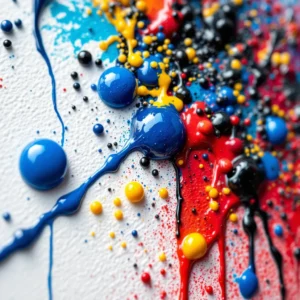
Imagine dancing with your paintbrush! That’s kind of what action painting is all about. This abstract painting technique is less about careful brushstrokes and more about the physical act of applying paint.
- What it is: Artists use dynamic movements like dripping, splattering, and even throwing paint onto the canvas. The final piece is a record of the artist’s energy and motion.
- Famous Artist: Jackson Pollock was a superstar of this technique. He would lay his canvas on the floor and move around it, dripping and splattering paint from cans and sticks. You can see his work at museums like the Museum of Modern Art (MoMA).
- How to try it (simplified):
- Lay your canvas flat (an old sheet underneath is a good idea!).
- Thin your acrylic paints slightly with water so they drip easily.
- Use sticks, old brushes, or even your hands to drip, flick, or splatter paint onto the canvas.
- Experiment with different colors and movements. Let loose and have fun! This is a core abstract painting technique for expressing raw energy.
“The painting has a life of its own. I try to let it come through.”
Jackson Pollock
Action Painting, a key abstract painting technique, involves dynamic methods like dripping and splattering to convey energy and movement.
2. Palette Knife Painting & Impasto: Building Texture
If you love chunky, textured surfaces you can almost touch, then palette knife painting and impasto are abstract painting techniques you’ll adore.

- What it is: Instead of a brush, you use a palette knife (a blunt, flexible blade) to apply thick layers of paint. Impasto is the term for this thick application where the knife or brush strokes are visible. You can learn more about mastering texture painting techniques to add another dimension to your work.
- Why it’s cool: It creates amazing textures, depth, and a 3D effect. The way light hits the raised paint can make your artwork change throughout the day.
- How to try it:
- Use thick-bodied acrylics or oil paints.
- Scoop up paint with your palette knife.
- Spread it on the canvas like frosting a cake. You can dab, scrape, or make smooth strokes.
- Don’t be afraid to layer colors! This abstract painting technique is all about bold texture.
The impasto technique, often applied with a palette knife, adds rich texture and dimensionality to abstract paintings using this abstract painting technique.
3. Color Field Painting: Emotions in Hues (Soak Stain & Layering)
Imagine huge canvases filled with vast areas of color that seem to float and shimmer. That’s color field painting, an abstract painting technique that’s all about the power of color to evoke emotions.
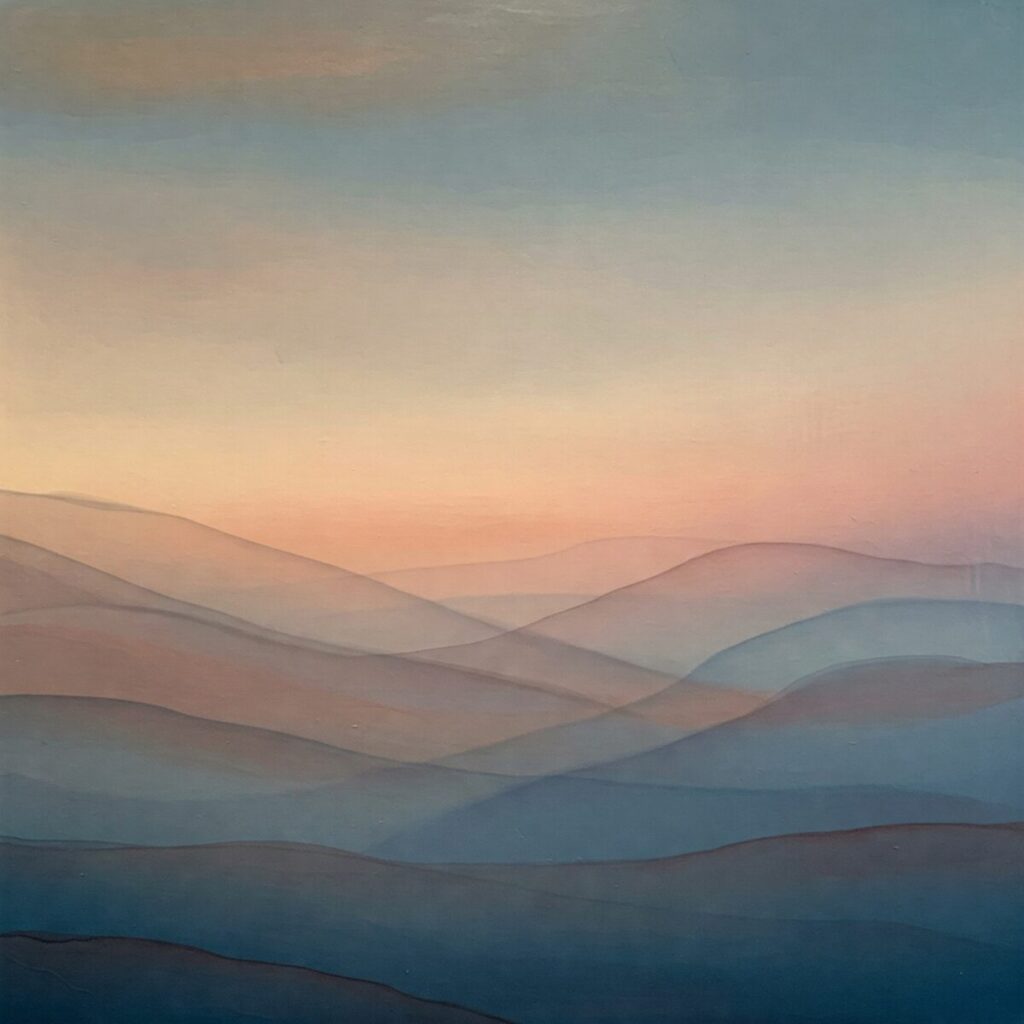
- What it is: This style focuses on large, flat areas of solid color. Artists often use techniques like soak stain, where thinned paint soaks into an unprimed canvas, creating soft, atmospheric effects. Layering thin washes of color also builds up luminous, complex hues. If you’re interested in how colors can dominate a piece, explore modern abstract painting with bold colors.
- Famous Artists: Mark Rothko and Helen Frankenthaler were pioneers. Rothko’s paintings with their glowing rectangular blocks of color are meant to be immersive experiences. Frankenthaler developed the soak-stain technique, pouring thinned paint onto canvas to create ethereal, transparent fields of color. Check out Rothko’s work at the Tate Modern.
- How to try soak stain (simplified):
- Use raw, unprimed cotton canvas (or prepare your canvas with a clear gesso if you want more control but still some absorbency).
- Heavily dilute your acrylic paints with water or a flow medium like those from Golden Artist Colors.
- Pour or brush the thinned paint onto the canvas, letting it soak in and spread.
- Tilt the canvas to let colors flow and merge. This abstract painting technique is about creating mood through color.
4. Geometric Abstraction: Order in Shapes (Masking & Hard Edges)
If you like clean lines, sharp shapes, and a sense of order, geometric abstraction is an abstract painting technique that will appeal to you. It’s like building with color and form. Understanding shapes and lines in abstract art is key here.
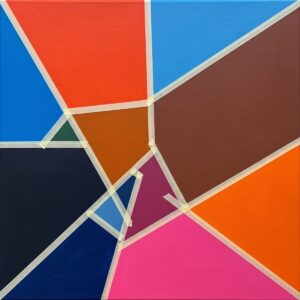
- What it is: This style uses geometric shapes—squares, circles, triangles, rectangles—in a non-representational way. Hard-edge painting is a type of geometric abstraction where the shapes have crisp, clearly defined edges.
- Famous Artist: Piet Mondrian is a classic example with his famous grids of black lines and blocks of primary colors. His work influenced not just art but also design and architecture. This structured approach contrasts with the more organic abstract painting techniques.
- How to get hard edges:
- Plan your design. Lightly sketch your geometric shapes on the canvas.
- Use painter’s tape (the blue kind works well) to mask off areas you don’t want to paint yet. Press the edges down firmly to prevent paint from seeping under.
- Paint one color area. Let it dry completely.
- Carefully remove the tape. Then, tape off new sections for different colors.
- This methodical abstract painting technique leads to very clean and impactful results.
5. Expressive Mark Making & Layering: Your Unique Signature
This is a broad category of abstract painting techniques that’s all about leaving your personal touch on the canvas. It’s intuitive and allows for a lot of experimentation.
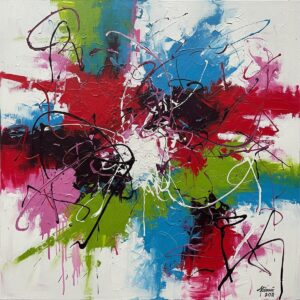
- What it is: Mark making refers to the different types of lines, dots, scribbles, patterns, and textures you create. Layering involves building up these marks and colors over time, letting some of the earlier layers show through. This can create a rich history and depth in your painting. Consider exploring 25 innovative abstract painting ideas for inspiration.
- Techniques within this:
- Sgraffito: Scratching through a top layer of wet paint to reveal the color underneath.
- Gestural strokes: Using bold, sweeping brushstrokes that show your arm’s movement.
- Stippling: Creating an image with tiny dots.
- Scumbling: Applying paint in a loose, scrubbing motion to create a broken color effect.
- How to explore:
- Don’t overthink it! Grab different tools – brushes of all sizes, sponges, twigs, palette knives, even old credit cards.
- Experiment with making different kinds of marks. How does a thick line feel different from a thin one? What if you drag a dry brush across the canvas?
- Build up layers. Let some dry and paint over them. Scrape some away. This approach to abstract painting techniques is very personal.
Other Exciting Abstract Painting Techniques to Try:
- Pouring: Acrylic pouring is a hugely popular abstract painting technique where you mix acrylic paints with a pouring medium and then pour them onto your canvas. The paints interact to create mesmerizing cells and patterns. It’s like a beautiful science experiment!
- Collage/Mixed Media: Who says you can only use paint? Abstract art often incorporates other materials like paper, fabric, sand, or found objects. This is a great way to add unique textures and meanings. If you’re just starting out, consider looking into painting techniques for beginners.
- Digital Abstract Art: With modern tools, you can also explore abstract painting techniques digitally, using software to create stunning non-representational works.
Watch and Learn: Abstract Art Techniques in Action
Sometimes seeing is believing! Here’s a video that demonstrates some easy abstract painting techniques for beginners:
Materials for Your Abstract Adventure
You don’t need a fancy studio to get started with these abstract painting techniques. Here are some basics. For a more detailed look, check out a complete guide to art mediums.
| Material | Description | Why it’s useful for abstract art |
|---|---|---|
| Acrylic Paints | Water-based, fast-drying, versatile. Come in various consistencies. | Great for layering, texture, and vibrant colors. |
| Canvases | Stretched cotton or linen. Canvas boards are good for practice. | Your surface for creation! |
| Brushes | Variety of shapes and sizes (flats, rounds, filberts). | For different strokes and effects. |
| Palette Knives | Flexible metal or plastic blades. | For impasto, scraping, and applying thick paint. |
| Palette | Surface for mixing paints (disposable paper palettes are easy). | Essential for color mixing. |
| Water Container | For rinsing brushes (if using acrylics). | Keeps your colors clean. |
| Optional Extras | Pouring medium, texture gels, masking tape, sponges, found objects. | For specific abstract painting techniques. |
Exploring different abstract painting techniques is a journey of discovery. There’s no right or wrong, only what feels expressive and interesting to you. Artists like Wassily Kandinsky, often called the pioneer of abstract art, believed that colors and shapes could communicate emotions just like music. You can learn more about how Kandinsky influenced Abstract Expressionism. Even earlier movements like Cubism, explained in this beginner’s guide, helped pave the way for artists to break from realistic representation, providing a foundation for many abstract painting techniques.
The beauty of these abstract painting techniques is their adaptability. You can combine them, invent your own variations, and truly make them your own. The goal is not to perfectly replicate a technique but to use it as a starting point for your own creative voice. Remember, understanding color theory basics can also significantly enhance your ability to create impactful abstract art.
As you practice these abstract painting techniques, you’ll start to develop your own style. Don’t be afraid to make “mistakes” – often, they lead to the most interesting discoveries! The world of abstract art is vast and welcoming, so pick up a brush (or a stick, or a palette knife!) and explore the incredible freedom of non-representational abstract painting techniques.
FAQ: Your Questions About Abstract Painting Techniques Answered
Q: What are the different types of abstract art?
A: Abstract art is a broad term! Some main types include Geometric Abstraction (using shapes), Abstract Expressionism (focusing on emotion and spontaneous gestures, which heavily uses various abstract painting techniques), Color Field Painting (large areas of flat color), Lyrical Abstraction (more flowing and poetic), and Minimalist Art (simplified to its most basic elements). Many artists also blend styles.
Q: How do you paint abstract art for beginners?
A: Start simple!
- Choose a few colors you like.
- Focus on one or two abstract painting techniques from this article, like dripping or simple layering.
- Don’t try to make it look like something specific. Instead, focus on the process, how the colors mix, and the textures you create.
- Most importantly, have fun and don’t judge your work too harshly. Check out Prominent Painting’s top 10 abstract artists for inspiration!
Q: Who are some famous abstract artists?
A: Besides Jackson Pollock and Mark Rothko, other famous abstract artists include Wassily Kandinsky, Piet Mondrian, Willem de Kooning, Joan Mitchell, Helen Frankenthaler, and Kazimir Malevich. Each had their unique approach to abstract painting techniques.
Q: How do you paint abstract art with acrylics?
A: Acrylics are fantastic for abstract painting techniques because they are versatile and dry relatively quickly.
- You can use them thick for impasto or thin them with water/medium for washes and drips.
- They are great for layering because once a layer is dry, you can paint over it without disturbing it.
- Experiment with acrylic mediums (like gloss, matte, or texture gels) to change the paint’s properties.
Q: What are some abstract painting ideas?
A: Paint your emotions: Choose colors and make marks that represent how you’re feeling.
- Inspired by music: Listen to a piece of music and translate the sounds and rhythms into paint.
- Nature’s textures: Look closely at tree bark, water ripples, or clouds and use those as inspiration for textures and forms.
- Limit your palette: Try creating a whole painting using only two or three colors plus black and white. This can teach you a lot about value and mixing with abstract painting techniques.
Q: What is non-objective art?
A: Non-objective art is a type of abstract art that is completely non-representational. It doesn’t draw its forms from the visible world at all. Instead, the artwork’s subject is its own colors, shapes, lines, and textures created through various abstract painting techniques.

